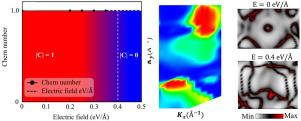二维ScV6Sn6 kagome材料的可调谐拓扑相
IF 9.7
2区 材料科学
Q1 MATERIALS SCIENCE, MULTIDISCIPLINARY
引用次数: 0
摘要
本文研究了二维钒基kagome金属ScV66Sn66的拓扑性质。ScV66Sn66是一种磁矩为0.86 μ b /原子的铁磁材料。使用从头算方法,我们探索了自旋轨道耦合引起的间隙态,并在费米能量周围识别了多个Weyl-like交叉,证实了一个chn数|C|=1|C|=1和一个大的反常霍尔效应(AHE)为257 Ω−1Ω−1cm−1。我们的计算揭示了在电场强度≈≈0.40 eV/Å下从拓扑半金属到平凡金属相的转变。这些发现将2D ScV66Sn66定位为现代电子设备应用的有前途的候选者,其可调谐的拓扑相位为量子计算和材料设计的未来创新提供了潜力。本文章由计算机程序翻译,如有差异,请以英文原文为准。


Tunable topological phase in 2D ScV6Sn6 kagome material
We investigate the topological properties of the vanadium-based 2D kagome metal ScVSn, a ferromagnetic material with a magnetic moment of 0.86 per atom. Using ab initio methods, we explore spin–orbit coupling-induced gapped states and identify multiple Weyl-like crossings around the Fermi energy, confirming a Chern number and a large anomalous Hall effect (AHE) of 257 cm−1. Our calculations reveal a transition from a topological semimetal to a trivial metallic phase at an electric field strength of 0.40 eV/Å. These findings position 2D ScVSn as a promising candidate for applications in modern electronic devices, with its tunable topological phases offering the potential for future innovations in quantum computing and material design.
求助全文
通过发布文献求助,成功后即可免费获取论文全文。
去求助
来源期刊

Materials Today Physics
Materials Science-General Materials Science
CiteScore
14.00
自引率
7.80%
发文量
284
审稿时长
15 days
期刊介绍:
Materials Today Physics is a multi-disciplinary journal focused on the physics of materials, encompassing both the physical properties and materials synthesis. Operating at the interface of physics and materials science, this journal covers one of the largest and most dynamic fields within physical science. The forefront research in materials physics is driving advancements in new materials, uncovering new physics, and fostering novel applications at an unprecedented pace.
 求助内容:
求助内容: 应助结果提醒方式:
应助结果提醒方式:


